About Sensurround
|
Read more
at in70mm.com The 70mm Newsletter |
| Written by: From the Sensurround manual | Date: March 18, 2004 |
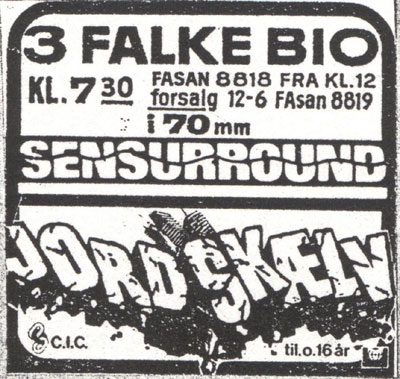 Danish
1974 advert for "Earthquake" in 70mm Sensurround. Hauerslev
collection. Danish
1974 advert for "Earthquake" in 70mm Sensurround. Hauerslev
collection.Recently theatres throughout the United States have been engaged with the showing of a top technically produced motion picture -- "Midway". This production as it is currently presented in theatres could not have been possible without technical field support. RCA Technical Services under contract to Universal Studios most recently installed approximately 300 Sensurround sound effects systems in theatres throughout the United States. RCA Services' association with Universal's special effects activity began in 1974 with the introduction of the motion picture "Earthquake" and the Sensurround I special sound effects system. This association has continued and has included the film "Midway". Universal Studios felt for many years that in order to attract large audiences into the theatres to see feature films, the viewing audience would have to be offered some sort of "event" that would not be accessible to them on the home television screen. People who make up audiences have a certain budget for outside of the home entertainment and Universal knew they had to provide something very special so the potential audience would choose to spend their money in a movie theatre, rather than in the ball park or concert hall. With this premise in mind, it occurred to this filmmaker that perhaps the way to make future films more attractive would be to augment the normal theatre experience with special sound effects. Thus, the Sensurround I effects system was created to produce the auditorium shaking sensations which were used in the movie production "Earthquake". In this Sensurround I system, low frequency sound was used to simulate earthquake rumbles and vibrations, and was to be of such intensity that it could be physically felt in the body as well as heard. To accomplish this task, a special sound system had to be conceived that could be used to augment a theatre's normal sound system. This special system had to be relatively portable and somewhat tailored to each theatre that would use it. Early in the project it was realized that none of the existing standard film recording techniques could effectively record and reproduce frequencies below 40HZ, the frequencies that could be physically felt in the body, so it was decided that each installation would be equipped with a low frequency noise generator. Low frequency control tones recorded on a special audio track were to regulate the timing and intensity of the low frequency rumble from the noise generator. |
Further
in 70mm reading: Introduction Sensurround @ the Schauburg Internet link: |
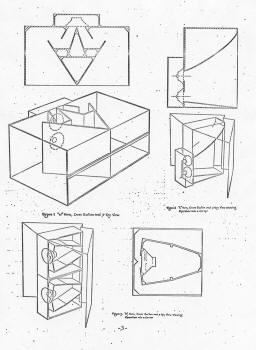 Sensurround
speaker cabinet x-rays. Click image to see
enlargement Sensurround
speaker cabinet x-rays. Click image to see
enlargementIt was thought that this control system offered the flexibility to control a variety of theatre effects. Consideration was given to dropping dummies in front of the screen but was dropped for its lack of realism. Also, another important design consideration was that the system had to be self operating so that once it was installed in a theatre no additional work would be imposed on theatre personnel to operate or maintain it. Audio equipment manufacturers were invited to participate in the Sensurround I system conception and were asked for equipment designs. The outcome resulted in the use of stock concert bass horns for use in the prototype demo system. For early demonstrations a General Radio random noise generator with low pass filter simulated the not-yet-designed system generator. Even though early demonstrations used tuned cabinets (one cubic meter) that had a response tuned to 15 HZ, it was confirmed that very low frequencies reproduced at sound pressure levels of about 120dB SPL (C scale, or flat response) did indeed give the illusion of actual physical vibration and movement. This sound was also physiologically effective when used with visuals depicting earthquake actions. |
|
Design Efforts |
|
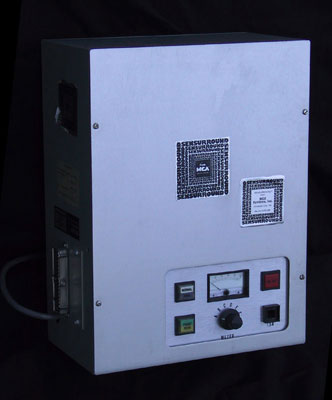 Sensurround
II control box. Hauerslev collection. Sensurround
II control box. Hauerslev collection.Design efforts began with the establishment of a design objective around 15 Hz. Many speakers were destroyed while trying to attain the necessary sound pressure levels. Because of this, it was decided that the horn design had to be efficient at these low frequencies. Designing a horn to operate with a cutoff frequency of 15 Hz -theoretically requires the horn mouth to be about 300 square feet in area. It also requires a slow taper rate thereby meaning the horn would have to be very long. Folding a horn to reduce its length usually results in degrading the frequency response, but only at frequencies well above the cutoff frequency. Since the normal theatre sound system was to handle the higher frequencies anyway, it was considered practical to fold the Sensurround horns. Reduction of the horn mouth area was accomplished by consideration of the fact that if the horn is located in a corner, the walls and floor of the theatre form boundaries, and restrict angle into which the horn radiates. If the area into which the horn operates is small, the mouth of the horn can be reduced. With a small mouth, some attenuation occurs just above cutoff and there exists some fluctuation in frequency response. Since continuous tones were not being reproduced in this system, the un-eveness in response was not considered important. Three horn configurations were developed for use in the Sensurround system and each type of horn used special 18" low frequency drivers. All horn designs prevented large cone excursions, which could be destructive to the reproducer. The first horn is a "W" horn with two fold backs to increase the length. It is difficult to transport because of its bulk. This horn does have application in theatres that require a low profile horn. |
|
"Earthquake" released formats |
|
 70mm
frame from "Earthquake". Universal Pictures 1974 70mm
frame from "Earthquake". Universal Pictures 1974"Earthquake" was released in the three standard theatre film formats; 6 track magnetic sound on 70mm film, 4 track magnetic sound on 35mm film, and the old standard single track optical sound on 35mm film. A system was devised to interface the Sensurround I effects to all of these formats. In reality the term "Standard" theatre sound equipment hardly has any meaning today. Some theatres have old sub par systems, while others have been updated partially and are hybrids; still others have new systems. This fact made it difficult to design a system that can be quickly and simply installed anywhere and work. W. O. Watson, retired former sound director for Universal, returned to work on the Sensurround project to assist R. J. Stumpf, the present director. Watson called on the experience of many former colleagues to install Sensurround in theatres in Europe, The Orient, Australia, South Americ, South Africa, etc. The Sensurround I system was not simple, yet it had to be easily installed and easily operated. The final Sensurround I system configuration consisted of the horns required for a given theatre, the amplifiers to drive them, and a special control box which is integrated into the theatre sound system between the projector changeover switch and the audio power amplifier. (Refer to diagram). The control electronics accommodates a wide variation in input and output levels and impedances. Also included are the digital random noise generator and the filters, which generated the earthquake, rumble effect. The rumble was turned on and off and otherwise controlled by circuitry tuned to control tones recorded on the audio track of the feature. Sensurround I used two control tones, one at 25Hz that controls the level of the rumble effect and another at 35Hz which is used to combine certain normal sound track sounds with the Sensurround rumble for added impact. The control tones are recorded at a maximum level of 30dB below 100% modulation, and have analog control range of 10dB. Tunable active filters separate the control tones. Since 25Hz and 35Hz are not widely separated, the detection filters are of necessity High Q to enhance selectivity, coupled with the fact that the control signals are low level, created a filter with a sluggish response time so the Q was reduced and dip filters preceded each control circuit. Some time constant lag remained, however, that had to be compensated for in the recording of the control tones. The dubbing mixers had to anticipate the action in the picture by turning the control on and off in advance of the screen action. For 35mm optical sound formats, the control tones are recorded on the normal sound track at a reduced level. For 35mm magnetic/optical formats, the control tones were recorded on the optical track. Since most magnetic projectors are also equipped for optical sound, the optical sound track was used for control tone recovery and if necessary an additional preamplifier was included in the Sensurround control electronics. When "Earthquake" was recorded on 35mm as an optical sound print, the control tones were mixed with the normal sound track material. The normal sound track sound was rolled off below 35Hz so that program sound would not trigger the effects. In the 70mm format (not used in the United States) two of the six magnetic tracks were devoted to 100Hz control tones used for effects gating and steering. During the development it was found that when the rumble was activated the normal sound appeared to diminish in intensity. Circuits were included in the control electronics to automatically increase the normal sound track level 6dB when the effects were gated into operation. This created a good subjective audio balance. In the initial planning stages for "Earthquake", it was estimated by the end of the first year of operation 17 theatres would be equipped with Sensurround. Nearly 400 were operational during the “Earthquake" showing. Installation and maintaining that amount of equipment in widely dispersed locations throughout the country required the service of a nationwide organization and the contract was awarded to Technical Services of the RCA Service Company. Regional RCA Service Company personnel were trained by Universal specialists, and they in turn went into the field and trained other RCA people. RCA Service Company personnel are now handling the installation and maintenance calls within the continental boundaries of the United States and also have covered the installation locations in Mexico, South America, and the Caribbean Islands. In addition, for the feature "Earthquake", RCA handled the transfer and installation of equipment into new locations. The RCA service men work closely with the theatre managers and Universal in evaluating the theatres and installing the equipment. Upon completion of an installation, careful sound pressure level measurements are taken to assure high quality performance of the system. The system is adjusted until an overall SPL of 95dB (A scale) is achieved at the center of the theatre, with no more than 110dB (C scale) 4 feet in front of any horn. These levels are deemed safe for human consumption continuously for periods up to 8 hours. |
|
Difficulties were Encountered |
|
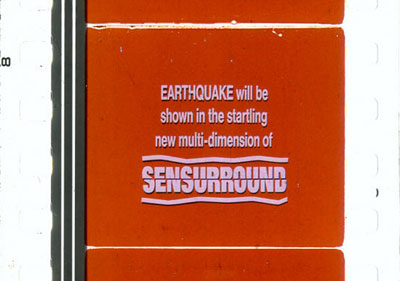 Anamorphic
35mm frame from the "warning" teaser. Hauerslev collection. Anamorphic
35mm frame from the "warning" teaser. Hauerslev collection.Even though the Sensurround I special effects system was designed to be versatile in regard to ease of installation, difficulties were encountered when a theatres' sound system deviated from the standard configuration. A standard theatre sound system historically consisted of 1. Projector sound pickup devices (Photo cells) 2. Preliminary amplification and playback equalization (preamps) 3. Projector selection (changeover switching mechanisms) 4. Auditorium equalization (compensation panel) 5. Final amplification (power amps), and 6. Sound reproducers consisting of a crossover network, high and low frequency speakers. Over the years since the concept of "standard theatre sound system" was conceived, the theatre business prospered then declined and gradually improved again. During the declining years, economy, non-standard sound systems were installed in older theatres to update the original equipment, and were also used in new theatre installations. The newer abbreviated systems are made of up single amplifiers containing preamps and power amps. Mere changeover switching was done before the amplifier. Auditorium equalization was done with simple bass and treble tone controls. Vacuum tubes systems were replaced with solid-state devices; photocells were replaced by phototransistors and solar cells. Some older theatre systems were hybrids, with some containing vacuum tube preamps and solid state power amps or vice versa. In other systems the photocells were removed, and replaced by higher gain solar cells necessitating amplifier circuit changes. Many such modifications or circuit changes were never recorded. Stereophonic magnetic sound, as introduced in the late 40's and again the hybriding of systems was compounded. Following the 4 track magnetic sound of the late 40's came the 6 track sound of 70mm Todd-AO. Again newer equipment was added to the older equipment. Today, a theatre sound system is more non-standard than standard hence the problems the RCA Service Company theatre man encountered were many and varied. The following paragraphs relate some of the problems encountered. The Motiograph A7505 sound amplifier would not pass the 25Hz and 35Hz control signal at an adequate usable level. This problem was easily corrected by increasing the capacity of the preamps coupling capacitors. Once a solution was determined by the RCA Service Company tech for a specific manufacturer's equipment, Universal Studios sound people recorded the information and passed it on to the service company people who would become involved with the specific equipment on future installations. This joint effort reduced installation time and installation problems. During the practical work of installation, problems were encountered that seemingly couldn't exist. Universal Studios had developed a Sensurround setup procedure using special test film that was performed by the RCA man. The final checkout was done with a short reel of the actual film. In some cases after the setup procedure was performed, the effects from the test reel were intermittent or non-existent. This problem was resolved and found to be caused by excessive output levels from the preamps at 25HZ and 35HZ into the Sensurround control unit. On the control tone test films which were 400Hz with either a 25Hz or 35Hz frequency imposed on the track, the Sensurround control unit would work fine, however, on the sound track of an actual reel many frequencies appeared at once along with the control. Frequencies appeared as a modulation envelope on the normal sound. Since the basic level was too great within the preamp, the sound track signals were clipped in final preamp stage before the control electronics. This clipping action destroyed the control tones. Without the control tones no effects were present. This problem established a maximum preamp control signal output of about –10 dBm from the preamps. Some amplifiers did not clip the control tones on excessive sound track input to the control electronics because the low frequency response was poor. In this case if excessive signal output were fed to the control electronics, the normal low frequency theatre sound would pass through the control electronics tone filters by brute force and activate the effects sound at the wrong time. Here again, a need was created for a maximum preamp output level to the control unit. A theatre projection booth can be a high noise environment with Xenon arc lamps, high current switching, brush motors etc. If the theatre's sound system was not installed with proper attention given to grounding, then noise could be a problem. Normally the Sensurround I system could work with control signal input levels as low as –40dBm to the control unit. Experience showed, however, that in high noise environment booths where the signal-to-noise ratio was poor, noise would trigger on the effects sounds. Switch clicks were particularly troublesome. From this experience coupled with the lesson learned from the ill effects of excessive signal, an optimum level of –20dBm was established. With this level at the output of the theatre's preamp, the control electronics functioned noise free and trouble free no matter what was encountered in the projection booth. The Simplex/Norelco XL2O optical sound system presented an interesting problem. This is a one-unit hybrid amplifier with the preamplifier portion transistorized and the power amplifier portion vacuum tubes. The coupling between the preamp and power amp is a transformer. |
|
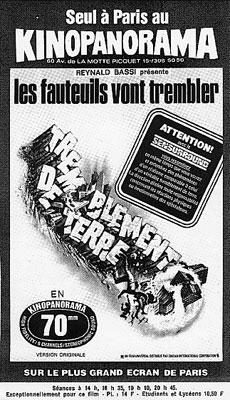 French
(From Paris) advert for "Earthquake" in 70mm Sensurround.
Hauerslev collection. French
(From Paris) advert for "Earthquake" in 70mm Sensurround.
Hauerslev collection.On the first attempt to connect this amp to the Sensurround I system, (refer to diagram), the coupling capacitor C2O was opened and the output of the preamp was fed to the Sensurround control electronics, the return from the control electronics went into a newly installed system gain control, and then returned to the power amplifier. Since no gain stage exists in the power amp, the new gain control had to be at maximum in order to obtain normal house levels. This of course would not be tolerable so the second attempt to break into the amplifier occurred at C10 the coupling capacitor following the first stage of amplification after the photo cells. At this point the control signals (25Hz and 35Hz) did not have enough gain for the Sensurround system. Finally the connection was made at C17 between transistor stages TS4 and TS5. Here the preamp gain was sufficient and the power amp gain was sufficient, however, the frequency response could be affected at this point by the treble and bass controls. The bass control setting had to be fixed, because if it were changed the control signal levels would be incorrect and system would not work properly, if it worked at all. This system (amplifier) is constructed as a plug-in unit and in the event of failure, the original amp is removed and the emergency amp is inserted. The Sensurround connections and new system gain control had to be unplugable to maintain this emergency feature. As a result of the experience gained in attempting to install Sensurround where a pickoff point had to be determined prior to disrupting the amplifier circuitry, preliminary measurements were made while running the test films to determine the point of adequate and desirable signal level. Speaker configurations and placement was predetermined by Universal Studios from a prospective theatre's floor plan. After an installation was accomplished and tested, the results may not have been adequate due to acoustical cancellation |
|
|
If speakers were in place and opposite one another, cancellation would occur reducing the sound effect. The RCA theatre sound man had to, in some instances, see that the speakers were repositioned to increase the effect and reduce dead spots due to acoustical cancellation. In several installations the proper control signal (25Hz and 35Hz) levels could not be obtained from the projectors. Since projector speed determines the frequency of the control tones, the RCA technician had to measure the frequencies of the control tones and make projector corrections to balance both theatre projectors. In some cases the control signal filters had to be compensated slightly. Special test films were prepared by Universal for use by RCA for this purpose. During the Sensurround I installations, specific installation instructions did not exist for the multitude of sound systems in existence. The RCA men went to their installation locations reviewed, the system or system diagrams (if available), and determined where the tie in points would be. As installations increased so did efficiency as many installations were duplicated over and over again at the theatres, and "the what to do", was previously determined. Because of the problems created by systems like the Simplex XL20, Universal in some cases supplied separate self contained transistor preamplifiers that tied directly to the sound pickup device, to give the necessary preamplification to the control electronics. When the signal was returned to the theatre's amp from the control electronics it was attenuated down to the pickup input level to run through the sound system in the usual manner. This method avoided interrupting the circuitry of the original sound system. This method was especially helpful in systems utilizing etched circuits. During the "Earthquake" installation, opening dates were frequent and usually four or five theatres opened in the same city, day and date. Since the equipment used in later openings was equipment removed from a theatre having just shown the feature, the equipment arrived at the new locations about two weeks before the new opening date. This meant that four or five installations had to be done in a given city during that period of time. Manpower had to be cleverly allocated geographically, and without a doubt installation time schedules had to be maintained. Because of close to the belt scheduling and occasional equipment failures, several openings were missed, but in some cases the misses were so close that although they opened on the proper date, the first feature showing of the day had to be postponed. |
|
300 theatres on the same date |
|
|
Later, for the "Midway" showing 300 theatres opened on the same date. Equipment preceded the installation with plenty of time to schedule installation and manpower, check the systems operation when once installed, and provide replacements for defective equipment with plenty of time to spare before the opening date. During the "run" of the feature at any given theatre, the RCA Service Company assured that the system worked properly. Failures occurred and sustaining maintenance was performed. The major problem appeared to be failures of power amplifiers. All installations had at least two power amps so if one failed the effect was not totally lost. Reserve or spare equipment was provided by Universal to each Service Company region office. As failures occurred, equipment was in the more serious cases swapped out sometimes to be repaired by RCA or sometimes by Universal's vendor depending on the seriousness and depth of the technical problem. The transducers or speaker systems also failed occasionally. Sometimes high frequency oscillations occurred to create these failures. Throughout the run of "Earthquake" various grounding systems were prescribed by Universal until the problem was solved. Logistics support had to be given to the theatre man in order that these sound systems could be maintained. The service man had to receive new equipment and return defective equipment, if repairs could not be effected. At first the main objective by Universal and RCA was to maintain system operation, but after failures mounted equipment inventory regulation and control became a problem. The service company initiated a plan to regulate defective equipment returns, while Universal directed their logistic efforts toward the shipment and relocation of equipments for installation. RCA and Universal worked jointly in both efforts, but in each area the efforts expended overcame unforeseeable problems that could have hampered or prohibited an installation or performance of the Sensurround system. As a result of failures, and failure analysis coupled with close operating contact between the RCA rep and Universal's sound department, several modifications were made to the Sensurround control unit before the feature "Earthquake" completed its run in theatres. At the outset of the installations for "Earthquake" approximately 17 theatres throughout the United States premiered the movie. Arrangements were made during these installations for the training program that indoctrinated and developed the RCA theatre man into a Sensurround installation and service specialist. Not all of the RCA field force could take advantage of the initial installation training, but key market area technicians were trained. These men in turn trained the other RCA men on the second installation go around. As time passed, personnel attrition took place due to retirements, etc., and attrition training was maintained by RCA. Universal Studios provided an original instruction book that basically covered Sensurround in its entire concept, but in some respects was not totally comprehensive due to the need to devote less time in this area and direct more attention to the more significant technical demands of other parts of the Sensurround program. Universal, with the aid and suggestions from RCA, prepared a second edition of the instruction book that filled in the first edition gaps. As the program continued on, an RCA technician suggested a better Sensurround setup procedure, which was less time-consuming and as comprehensive and effective as the original procedure. "Earthquake" was a successful venture that brought good gross profits and two Academy Awards to Universal Studios. As a result, the second Sensurround feature "Midway" was filmed and has recently played in theatres throughout the country. As a result of the combined experience in the field documentation by the RCA Service company and Universal Studios concerning the installation problems with the Sensurround I effects system, the Sensurround II system was developed for the movie "Midway". Nonstandard and sub-par theatre sound systems gave cause for installation and performance problems. For the "Midway" showing, solar cells were provided by Universal to the theatres having restricted low frequency response due to photo cells and vacuum tube preamps. This resulted in a general upgrading of the sound system, however, the RCA sound man had to make this modification insuring that the desired results were obtained. Universal Studios selected to use only the 35MM optical format for "Midway". The random noise generator was discarded and the effects sound was recorded directly on the optical track. In order to obtain an effective dynamic recording range of about 100dB for the Sensurround effect, DBX expansion and noise reduction was introduced as part of the control electronics. To overcome the sub-par sound in systems solar cells were installed as pickup devices for the "Midway" sound and the control electronics included an optical preamp compensatable to 10kHz. The control tones were retained at 25 and 35 Hz, however, the tones no longer control the timing and intensity of the effects but rather direct them through either the front, rear, or all Sensurround horns. "Midway" as in "Earthquake" has effects sound that reaches 95 to 100dB sound pressure level (SPL) on the "G" scale in the theatre. Special test films were also prepared by Universal for use by RCA Service personnel for the adjustment and setup of the Sensurround II system. Unlike "Earthquake" which premiered in 17 theatres throughout the country, "Midway" opened in almost 300 theatres simultaneously for its debut. The RCA Service Company did the installations and maintained them. Referring to "Earthquake", the viewing audience sometimes made non-technical comments, which were humorous to the RCA technicians. A comment often heard from the non-technical viewer was, "How do they shake the floor?" The Sensurround activity will continue in the forthcoming feature film "Rollercoaster" which will make its debut in 1977. Sensurround has no doubt extended the viewing potential of movies by extending the listening experience with a sense of feeling. |
|
|
Go: back
- top - back issues
- news index Updated 22-01-25 |
|
